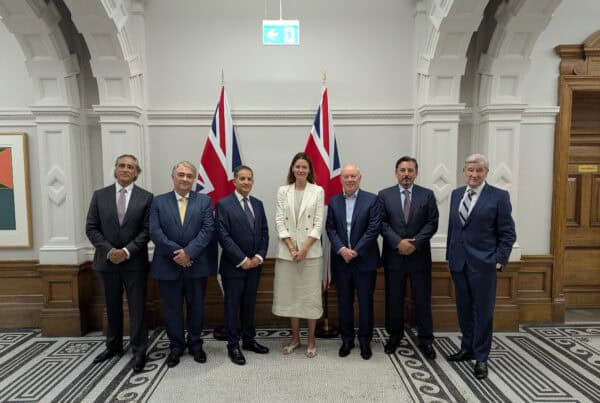
Across the UK, there are multiple free trade zones where businesses can benefit from global trade without adhering to the country’s typical customs regulations. These zones offer exceptional business opportunities, which, in turn, also support the country’s economy. On a global scale, free trade zones in the UK support international business by offering overseas companies great benefits and worldwide connections. With separate regulations from the rest of the UK, FTZs provide businesses with financial incentives, encouraging overseas businesses to set up and grow within these zones. For international businesses in the trade industry, FTZs in the UK are an excellent example of the future of global trade.
What is a UK Free Trade Zone?
UK free trade zones are geographically-defined areas of the country that have different taxation protocols. These free trade zones have exemptions on the tax typically applied to products that are imported and exported, providing businesses with a cost-efficient way to grow and trade internationally. Customs procedures are also streamlined to create a simplified process that eases administrative burdens that often come with customs processes.
Free trade zones are a type of Special Economic Zone, areas of the UK that support economic growth and encourage Foreign Direct Investment by attracting companies to set up business through financial incentives. While the term ‘free trade zone’ is not exclusive to Freeports, in the UK, most free trade zones are Freeports. A free trade zone can be any geographic area where customs duties are not collected immediately but due to their excellent locations close to airports and seaports, Freeports currently make up 100% of the UK’s free trade zones.
Free Trade Zones in United Kingdom
Across the UK, a total of twelve free trade zones are currently in operation, all of which are designated Freeports. While all Freeports have the same financial incentives and operate in a similar way, each has its own unique characteristics and benefits. Understanding the differences between free trade zones in the UK is crucial for overseas businesses looking to set up in the UK and choose the correct location.
Free Trade Zones in England
East Midlands Freeport
Positioned around East Midlands Airport, East Midlands Freeport is the UK’s only inland Freeport. This Freeport is designed to drive regional growth in logistics and advanced manufacturing with a central location that boasts excellent cross-country connections.
Freeport East
With three designated tax sites at Felixstowe, Harwick and Gateway 14 near Stowmarket, known as Freeport East, this Freeport combines major seaports and aims to help ambitious businesses thrive. It is an ideal springboard for overseas companies to access the European market with easy access to both London and Cambridge.
Humber Freeport
Taking advantage of the UK’s largest port complex, Humber Freeport surrounds the four major ports of Hull, Goole, Immingham and Grimsby. It is a world-leading hub for renewable energy and maximises opportunities for sustainable trade.
Liverpool City Region Freeport
This Freeport includes Liverpool’s port, the UK’s leading transatlantic port, handling 45% of the UK’s trade with the United States. Liverpool City Region Freeport provides businesses with the best connections to North America.
Plymouth and South Devon Freeport
Supporting maritime industries, this Freeport also focuses on defence and manufacturing, particularly in marine innovation. The FTZ provides excellent supply chain opportunities and is an asset to international trade.
Solent Freeport
Surrounding Southampton, Portsmouth and the Isle of Wight, Solent Freeport is an important trade gateway for the UK. Connecting European and global markets, Solent Freeport has a ground-breaking approach to the future of sustainable trade.
Thames Freeport
Spanning the banks of the River Thames, covering London Gateway, Tilbury and Ford Dagenham, Thames Freeport is one of the UK’s most important free trade zones with excellent global connections by both rail and sea. It also has direct access to Europe’s largest consumer market.
Teesside Freeport
The largest Freeport in the UK is centred on Teesport and connects the North of England to the rest of the world. The site empowers global trade at one of the UK’s largest integrated industrial economies, close to major trade hubs and offshore projects.
Free Trade Zones in Scotland
Firth of Forth Green Freeport
Located in Central Scotland, this Freeport focuses on offshore renewable energy with facilities for manufacturing and innovation. Boasting excellent rail and road connections, Firth of Forth offers direct access to the Scottish market and beyond.
Inverness and Cromarty Firth Green Freeport
Including Port of Cromarty Firth, Port of Nigg, Port of Inverness, Highland Deephaven and Port of Ardersier, the Inverness and Cromarty Firth Green Freeport is located in an area of Scotland that has supported North Sea oil and gas activity since the 1970s. Now in this new generation, it is leading the way to support low carbon manufacturing and sustainable trade.
Free Trade Zones in Wales
Anglesey Freeport
Currently in development, Anglesey Freeport will become the first Freeport in North Wales. Offering new opportunities for businesses across the globe, this free trade zone supports international trade through the region’s hub for low carbon innovation.
Celtic Freeport
The Celtic Freeport covers the ports of Talbot and Milford Haven making it Wales’ best connected free trade zone with exceptional connections by rail, road and sea.



